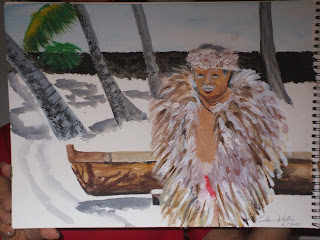Colleen Wallis Summer 2011
Can art and writing be integrated to support each content area?
ANNOTATED BIBLIOGRAPHY
Dr. Hill, an assistant professor at the University of Houston, worked with incarcerated teenage parents on literacy skills. She tells teachers that from the beginning of time, man’s earliest forms of written expression, from petro glyphs to calligraphy to hieroglyphs, art has always been a part of communication. Art and writing are inseparable. Hands on help with students from every situation, has shown that reluctant writers and readers have changed their perspective when encouraged to do artwork first. She says, “It was through art that young writers began to see themselves as writers.” Her observations and that of her colleague is that art is the key that enables the students to focus, to organize their thoughts and finally to write their thoughts based on their art work. Through their work with young parents, they are able to assist them to grow not only as responsible parents but also readers. By having them create their own Alphabet books and puppets, these young parents are able to present and dramatize their stories and write scripts and words. It is through art that they begin to see literature and writing as inseparable.
McNeese makes observations from his own earlier days as a teacher, comparing them to the present. NcNeese makes the connection of his teacher introducing the study of paintings and tying them in with literature. Basically, observation is the link to writing. He states that whether it is through drama or a work of art, it is the relationship between the two and the telling of it through writing that bridges the connection. Basically in the author’s interpretation, Art speaks. His paper gives seventeen exercises combining writing with painting, each having its own theme and goal. The exercises are made to show how close observation is fundamental to both visual and verbal expression.
Miller, S. R., & Hopper, P. F. (2010). Supporting goals through the visual arts. Reading Improvement, 47(1), 3-6. Retrieved from EBSCOhost.
Miller and Hopper are active members of The Mississippi Arts Commission whole school initiative program. They have written this article for teachers and administrators of all secondary schools. Their study was conducted in the Mississippi secondary schools.
The authors profess that a strong arts program in schools enhances creativity, independent thinking and all other areas of students’ development. They have found that those with strong art programs do better on achievement tests than do those with little or no arts in their curriculum. Students tend to feel that they have ownership of what they have learned so they have a higher perception of academic accomplishment. Teachers of all subjects, art included have to be willing to integrate other subjects with literacy. It’s up to the teachers to make sure that every student can read and comprehend what they are reading. They state several strategies for use in the art classroom, such as: Concept mapping, Journaling, outside reading and research assignments, comparing works of art, writing, Illustrating a short story, and much more. They have found that ELL students benefit from visualizations. They stress the importance of art whether through drama, performing or visual arts all benefit students by enhancing creative thinking and independent thinking. They also found that the art helps to develop cognitive and social skills in young adults.
Olshansky is a member of the National Council of teachers of English. As a teacher of English workshop, she observed her students through her own classes. These are her observations and findings. She found that reluctant students became more engaged when given the chance to create their own story and create in an art form first. Students actually wanted to tell their story repeatedly and wanted to record their own words that had meaning to them. Students were allowed to make collages first and then tell their stories. The Writing becomes a step that they choose to record their words. Her workshop was designed to treat words and pictures as an equal part in learning. When given the opportunity to move from picture to writing back again, they were able to bridge the gap between writing and artwork.
Raymond and Broderick, as members of a teaching K-8 visiting team, visited 144 Vermont schools. The authors documented how by using art as part of their curriculum, teachers have successfully reached students who struggle academically, to achieve new heights in other subject areas. The integration of the arts in the curriculum helped students blossom and become enthusiastic participants in classroom life. Those teachers, who had to incorporate art into their curriculum, found that they already had some form of latent art talent in their repertoire. Some were dancers, some writers, while others artists or just enthusiastic appreciators of art. There are numerous resources available for all teachers to use as artifacts to teach visual thinking strategies to students. Music and dancing as well as the visual arts can be incorporated into every subject. All it takes is the commitment of the entire staff to integrate the arts across the curriculum. The integration was federally funded and had an expiration date but it started a trend that continues until today. Teachers are also learners, so they took classes, modeled what they learned to their students throughout the year.
